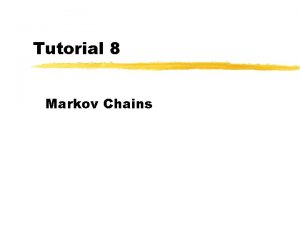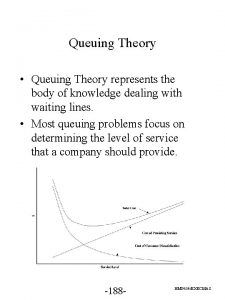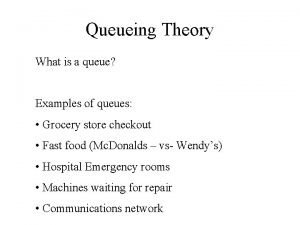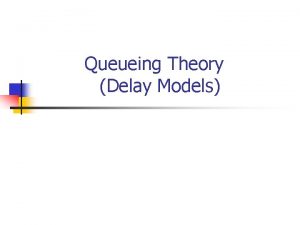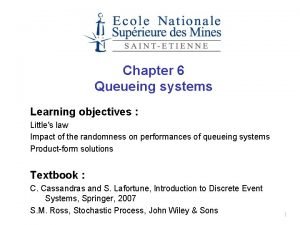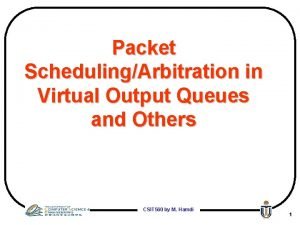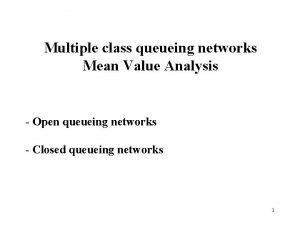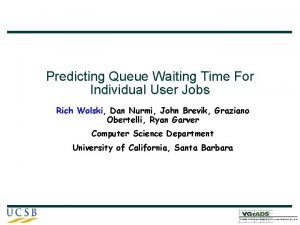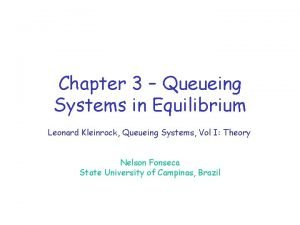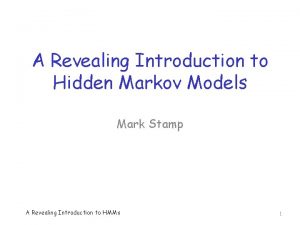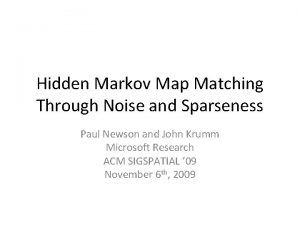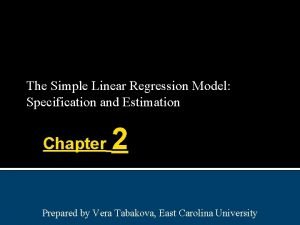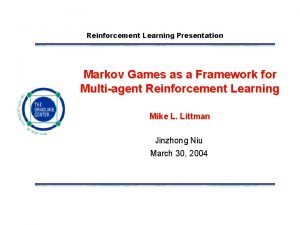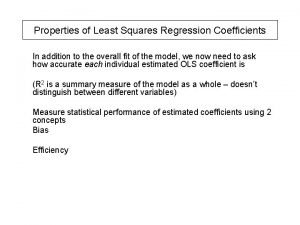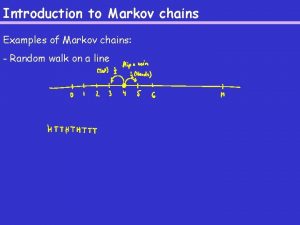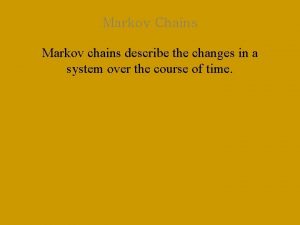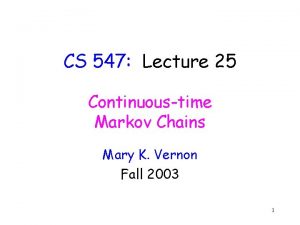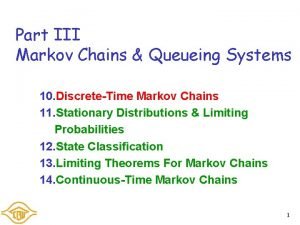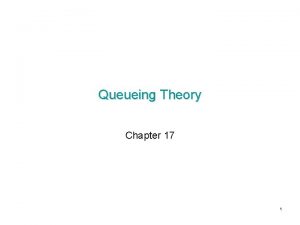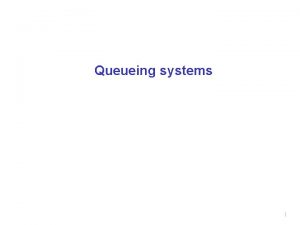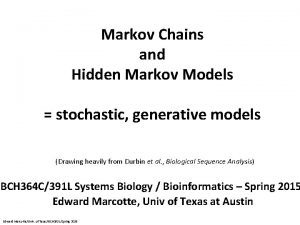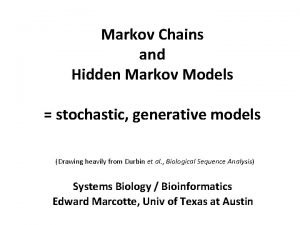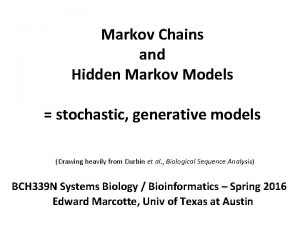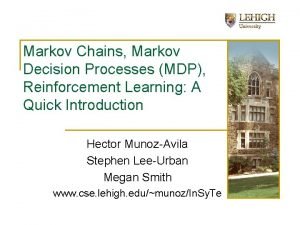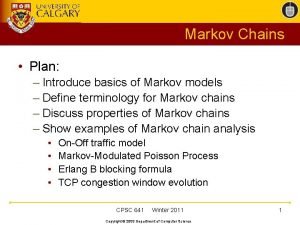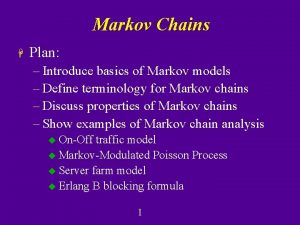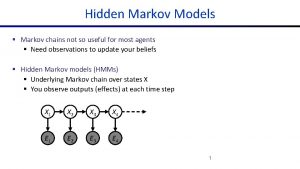Introduction to ContinuousTime Markov Chains and Queueing Theory


















![Little’s Law: Additional Results Q: What about E[TQ]? v number of jobs in queue Little’s Law: Additional Results Q: What about E[TQ]? v number of jobs in queue](https://slidetodoc.com/presentation_image_h2/acb8e8f9eea0af404c72c0bb6acb534a/image-19.jpg)













- Slides: 32

Introduction to Continuous-Time Markov Chains and Queueing Theory Thrasyvoulos Spyropoulos / spyropou@eurecom. fr Eurecom, Sophia-Antipolis

From DTMC to CTMC p 00 p 01 p 12 1 0 p 10 1. pk-1, k 2 … k-1 p 21 pk, k-1 DTMC 1. Transitions at discrete time steps n=0, 1, 2, … 2. Past doesn’t matter (Markov property) k+1 k … pk, k-1 CTMC Transitions between states can happen any time 2. Past still doesn’t matter P(Xn+1|Xn, Xn-1, …X 1) = P(Xn+1|Xn) 3. P(Xn+1 = j|Xn = i) = pij (stationarity) Thrasyvoulos Spyropoulos / spyropou@eurecom. fr 3. Transition still independent of time t Eurecom, Sophia-Antipolis 2

CTMC: A Generic Definition Ø A CTMC is continuous time stochastic process {X(t), t ≥ 0}, s. t. for all s, t ≥ 0, and any i, j, x(u) P{X(t+s) = j|X(s) = i, X(u) = x(u), 0≤ u≤ s} = P{X(t+s) = j|X(s) = i} (Markov property) = P{X(t) = j| X(0) = i} (stationarity) Ø τi : time until CTMC leaves state i, if currently in i Ø Above def. implies: P{τi > t+s | τi > s} = P{τi > t} Ø Q: What does this imply? Ø A: τi is exponentially distributed! Thrasyvoulos Spyropoulos / spyropou@eurecom. fr Eurecom, Sophia-Antipolis 3

CTMC: Viewpoint 1 exp(vi) i pij pik pil j k l Ø Step 1: When at state i, wait an exponentially distributed amount of time v denote rate out of: vi Ø Step 2: When the process leaves i, it will enter j with probability pij Thrasyvoulos Spyropoulos / spyropou@eurecom. fr Eurecom, Sophia-Antipolis 4

CTMC: Viewpoint 2 (more common) λ 01 0 λ 02 λ 03 1 exp(λ 01) 2 exp(λ 02) 3 exp(λ 03) Ø When at state i: v move to state j with rate λij (independently) Q: Time to leave state i? v first move to any state first phone rings A: Exponential with rate (vi = λi 1 + λi 2 +…+λin = Σj λij) Q: Probability to go to state k, after leaving i? A: Thrasyvoulos Spyropoulos / spyropou@eurecom. fr View 2 => View 1 Eurecom, Sophia-Antipolis 5

A Single Server Example Poisson (λ) e. g. 3 jobs/sec service: exp(μ) e. g. 5 jobs/sec λ 2 1 0 λ λ μ μ … μ Ø Let πj = limt ∞Pij(t) : limit probability of being in state j Q: How do we determine πj ? v how do we “solve” the chain? A: Assume an equivalent DTMC v “half-rigorous” argument Thrasyvoulos Spyropoulos / spyropou@eurecom. fr Eurecom, Sophia-Antipolis 6

CTMC DTMC with time unit δ DTMC (time step δ 0) CTMC λ 2 1 0 μ λ λ μ λδ+o(δ) μ 2 1 0 … λδ+o(δ) μδ+o(δ) … μδ+o(δ) Ø Divide time into very small intervals δ Ø Prob. of an arrival in the next interval δ : λδ + o(δ) Ø Prob. of a departure in the next interval δ : μδ + o(δ) Ø P{i i+1} = λδ (1 -μδ) = λδ + o(δ) (1 arrival + 0 departure) Ø P{i i-1} = μδ (1 - λδ) = μδ + o(δ) (0 arrival + 1 departure) Ø P{i i} = 1 - λδ -μδ +o(δ) (no event with almost prob 1) v we can ignore self-loops in the balance equations Thrasyvoulos Spyropoulos / spyropou@eurecom. fr Eurecom, Sophia-Antipolis 7

Solving the Balance Equations for a CTMC λδ+o(δ) Ø Methodology μδ+o(δ) … μδ+o(δ) Ø For state 1 Ø For state 0 rate out 2 1 0 Step 1) Write balance equations v Step 2) Take limit as δ 0 v λδ+o(δ) = Thrasyvoulos Spyropoulos / spyropou@eurecom. fr rate in rate out Eurecom, Sophia-Antipolis = rate in 8

Solving a CTMC – Our first Queueing Result! Ø Lesson from previous example: can simply solve the balance equations, rate in = rate out See book (MHB, CH. 12) for generalization v Can also try local balance equations v Need to check for irreducibility (for πi to exist) v - What about periodicity? ? Ø Back to our queue) Ø Define ρ = λμ Poisson (λ) service: exp(μ) (utilization) (we derived earlier) (normalize to get π0) Our first continuous time queueing result!! Thrasyvoulos Spyropoulos / spyropou@eurecom. fr Eurecom, Sophia-Antipolis 9

Introduction to Queueing: M/M/1 Poisson (λ) service: exp(μ) Ø The example so far was an M/M/1 system “M” stands for memoryless --- both arrivals and departures v “ 1” for single server v πn : number of customers in system (in service or queue) v Q: What is the probability that the server is empty? A: π0=1 -ρ Q: What is the expected number of customers? A: Thrasyvoulos Spyropoulos / spyropou@eurecom. fr Eurecom, Sophia-Antipolis 10

M/M/1 continued Q 1: What happens when ρ 1 ? (i. e. system very busy) A: (queue goes to infinity!) Q 2: What happens to the Markov Chain when ρ ≥ 1 ? A: All states become transient πi = 0 (for all i) Null-recurrent for ρ = 1 v But this means we cannot apply balance equations (no balance!) v Q 3: We know E[N]; What is the expected delay E[T]? A: Little’s Law will tell us that E[T] = E[N]/ λ Thrasyvoulos Spyropoulos / spyropou@eurecom. fr Eurecom, Sophia-Antipolis 11

Introduction to Queueing Theory Thrasyvoulos Spyropoulos / spyropou@eurecom. fr Eurecom, Sophia-Antipolis 12

Queueing Systems: Kendall’s Notation Ø A queuing system is described by A/D/n/B/S Ø A: the arrival process v v v M: for Memoryless Poisson arrivals D: Deterministic arrivals at fixed intervals G: generic distribution Ø D: service process v v v M: Memoryless duration of service is exponentially distributed D: Deterministic each service last the same fixed amount of t G: generic distribution (e. g. uniform, pareto, gamma, etc. ) Ø n: number of servers Ø B: size of queue/buffer v v If queue is full additional arrivals are rejected No B in notation infinite queue (e. g. M/M/1, M/G/1, G/G/4) Ø S: Scheduling policy v FCFS (default assumed), preemptive, random, etc. Thrasyvoulos Spyropoulos / spyropou@eurecom. fr Eurecom, Sophia-Antipolis 13

Queue Stability service: exp(μ) Poisson (λ) For the system to be stable: λ < μ Q: What happens if λ > μ? A: Queue size goes to infinity (and so does delay!) Q: Can you give the intuition? A: Consider an interval [0, t] (large t) Number in system = (arrivals in [0, t]) – (departures in [0, t]) Þ Number in system ≥ λt – μt = (λ- μ)t Þ t -> ∞ queue size -> ∞ v Thrasyvoulos Spyropoulos / spyropou@eurecom. fr Eurecom, Sophia-Antipolis 14

Throughput of a Queueing System Throughput X: jobs/min leaving the system Q: Which of the two systems has a higher throughput? A: The throughput is the same for both: X = λ = 1/6 Ø Consider a busy period of the system v Def: from time an arrival finds system empty, until it empties again Ø Assume A arrivals during a busy period Q: How many departures during that busy period? A: Exactly A! v All arrived jobs should complete for the system to empty Open (stable) system: Throughput X = Input Rate Thrasyvoulos Spyropoulos / spyropou@eurecom. fr Eurecom, Sophia-Antipolis 15

Little’s Law M/M/1: Poisson (λ) (or the most famous Queueing Result) service: exp(μ) Ø E[N] : number of customers in the system (queue + server) Ø E[T]: time a customer spends in the system (queue+server) Little’s Law: E[N] = λ E[T] Ø M/M/1: Ø (some) Intuition behind Little’s Law Customer X arrives at the end of a queue on average stays E[T] v Q: how many customers have arrived while X was in the system? v A: λ E[T] v => on average a departure leaves E[N] = λ E[T] customers in the system v Thrasyvoulos Spyropoulos / spyropou@eurecom. fr Eurecom, Sophia-Antipolis 16

Proof of Little’s Law Ø DEF: A is the area inside boxes Ø A(t): num of arrivals by t Ø D(t): num of departures by t area A N(t 2)=3 1. Sum times horizontally N(t 1)=2 t 1 t 2 2. Sum times vertically: Thrasyvoulos Spyropoulos / spyropou@eurecom. fr Eurecom, Sophia-Antipolis 17

Generality of Little’s Law Q: Did we assume anything about the number of servers? A: No! Q: Did we assume that scheduling is first-come first-serve (FCFS)? A: No! In fact, in the previous example 3 finishes before 2! Little’s Law applies to ANY system and ANY scheduling v Many servers, many queues, queueing network, scheduling policy Thrasyvoulos Spyropoulos / spyropou@eurecom. fr Eurecom, Sophia-Antipolis 18
![Littles Law Additional Results Q What about ETQ v number of jobs in queue Little’s Law: Additional Results Q: What about E[TQ]? v number of jobs in queue](https://slidetodoc.com/presentation_image_h2/acb8e8f9eea0af404c72c0bb6acb534a/image-19.jpg)
Little’s Law: Additional Results Q: What about E[TQ]? v number of jobs in queue – not server(s) A: λE[TQ] = E[NQ] (similar proof) Q: What about ρ (number of customers in service)? A: λE[S] = ρ ρ = λ/μ Q: What is ρ? A: System utilization -> fraction of time server(s) is busy (time average) A: Ergodicity Prob{server is busy at a random time} (ensemble average) Thrasyvoulos Spyropoulos / spyropou@eurecom. fr Eurecom, Sophia-Antipolis 19

M/M/k/k loss system Ø Consider a call center with k total lines v E. g. an actual call center, or switch with k circuits, or base station with k channels Ø If all servers/lines busy call/job is rejected Ø (Key Question): What is the probability of “blocking”? Thrasyvoulos Spyropoulos / spyropou@eurecom. fr Eurecom, Sophia-Antipolis 20

(continuous-time) Markov Chain for M/M/k/k Q: How many states do we need? A: k states Q: What is the rate from i to i+1? A: λ Q: What is the rate from i to i-1? A: kμ Thrasyvoulos Spyropoulos / spyropou@eurecom. fr Eurecom, Sophia-Antipolis 21

Local balance equations for M/M/k/k Q: Is the chain time-reversible (to apply local balance)? v i. e. is rate from 1 2 = rate from 2 1? A: Yes, it is so, we can apply local balance Erlang B Thrasyvoulos Spyropoulos / spyropou@eurecom. fr Eurecom, Sophia-Antipolis 22

What about general service (M/G/k/k)? Q: Job size/duration is not exponential? A: Turns out that the state probabilities πi is as in M/M/k/k Ø The block probability is the same and given by Erlang B Ø This is an important insensitivity result Result is insensitive to service distribution (only depends on mean μ) v Insensitivity results often arise when there is no queueing v Thrasyvoulos Spyropoulos / spyropou@eurecom. fr Eurecom, Sophia-Antipolis 23

M/M/k Dispatch to first available server queue if all busy Exponential service with rate μ Poisson (λ) A very important model for server farms v Amazon, Google, CNN, pretty much all major web sites v Cloud computing Thrasyvoulos Spyropoulos / spyropou@eurecom. fr Eurecom, Sophia-Antipolis 24

CTMC for M/M/k … Q: How many states? A: Infinite states Q: What is the rate from i i+1 A: λ Q: What is the rate from i i-1 (i ≤ k) A: iμ Q: What is the rate from i i-1 (i > k) A: kμ Thrasyvoulos Spyropoulos / spyropou@eurecom. fr Eurecom, Sophia-Antipolis 25

Local Balance Equations for M/M/k … Thrasyvoulos Spyropoulos / spyropou@eurecom. fr Eurecom, Sophia-Antipolis 26

M/M/k: Utilization and Queueing Q: What is the expected number of busy servers? A: λ /μ - Definition: ρ = λ /kμ (utilization of a single server) Q: What is the probability (PQ) an arriving job must queue? A: PQ = P{arrival finds all servers busy} = P{arrival sees ≥ k jobs in system} (from PASTA property) Erlang C: Thrasyvoulos Spyropoulos / spyropou@eurecom. fr Eurecom, Sophia-Antipolis 27

M/M/k Queueing vs. M/M/k/k Blocking Q: For which system (M/M/k and M/M/k/k) is the probability that all k server are busy higher? A: For the M/M/k Q: Why? A: In M/M/k jobs can arrive when all k servers are busy these do not disappear but queue up more work for later v In M/M/k/k these jobs are simply rejected v Can confirm by comparing Erlang B and C (work the math as HW) v Thrasyvoulos Spyropoulos / spyropou@eurecom. fr Eurecom, Sophia-Antipolis 28

(Back to) Comparing Channel Allocations …or server organizations…or supermarket lines… Q: Which is better in terms of E[T], FDM or M/M/1 (statistical multiplexing) A: M/M/1 E[TFDM] = k/(kμ-λ) but E[TM/M/1] = 1/(kμ-λ) Thrasyvoulos Spyropoulos / spyropou@eurecom. fr Eurecom, Sophia-Antipolis 29

(Back to) Comparing Channel Allocations (cont’d) …or server organizations…or supermarket lines… Q: What about E[TM/M/1] and E[TM/M/k]? A: ρ≈0 ρ≈1 Thrasyvoulos Spyropoulos / spyropou@eurecom. fr Eurecom, Sophia-Antipolis 30


 Transition matrix example
Transition matrix example Queuing theory formula
Queuing theory formula Queuing theory
Queuing theory Mm1 system
Mm1 system Erlang b
Erlang b Virtual output queueing
Virtual output queueing Queueing
Queueing Predictive queueing
Predictive queueing Kleinrock queueing systems
Kleinrock queueing systems A revealing introduction to hidden markov models
A revealing introduction to hidden markov models A revealing introduction to hidden markov models
A revealing introduction to hidden markov models Hidden markov map matching through noise and sparseness
Hidden markov map matching through noise and sparseness Retail and distribution chains
Retail and distribution chains Food chain and web
Food chain and web How does energy flow in an ecosystem
How does energy flow in an ecosystem Level of nourishment in a food chain
Level of nourishment in a food chain Food chains, food webs and ecological pyramids
Food chains, food webs and ecological pyramids Lab food chains and energy in ecosystems
Lab food chains and energy in ecosystems Why does organism eat another organism
Why does organism eat another organism Desert ecosystem food web
Desert ecosystem food web Difference between food webs and food chains
Difference between food webs and food chains Lifting tools and tackles safety pdf
Lifting tools and tackles safety pdf The earth will shake and tremble before him
The earth will shake and tremble before him Markov chain absorbing state
Markov chain absorbing state Gauss markov assumptions
Gauss markov assumptions Markov analysis
Markov analysis Hidden markov chain
Hidden markov chain Bing
Bing Hidden markov model rock paper scissors
Hidden markov model rock paper scissors Mdp example
Mdp example Gauss markov assumptions
Gauss markov assumptions Cov(ui uj)=0
Cov(ui uj)=0 Bayes filter algorithm
Bayes filter algorithm
